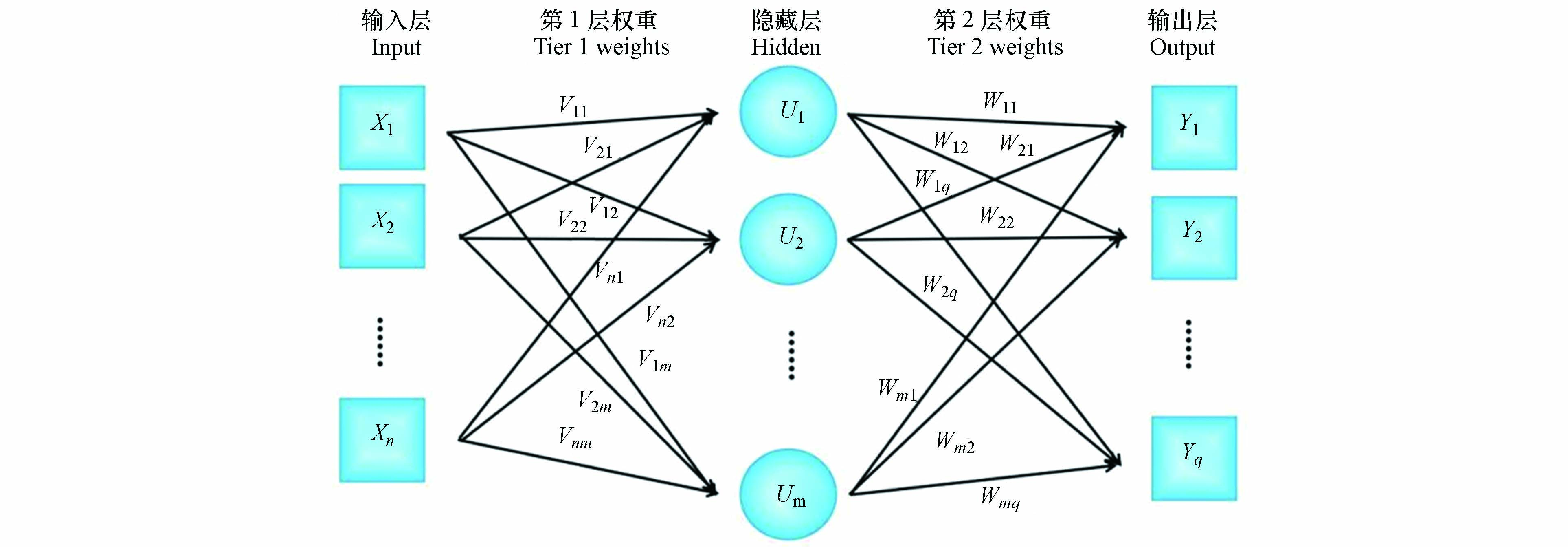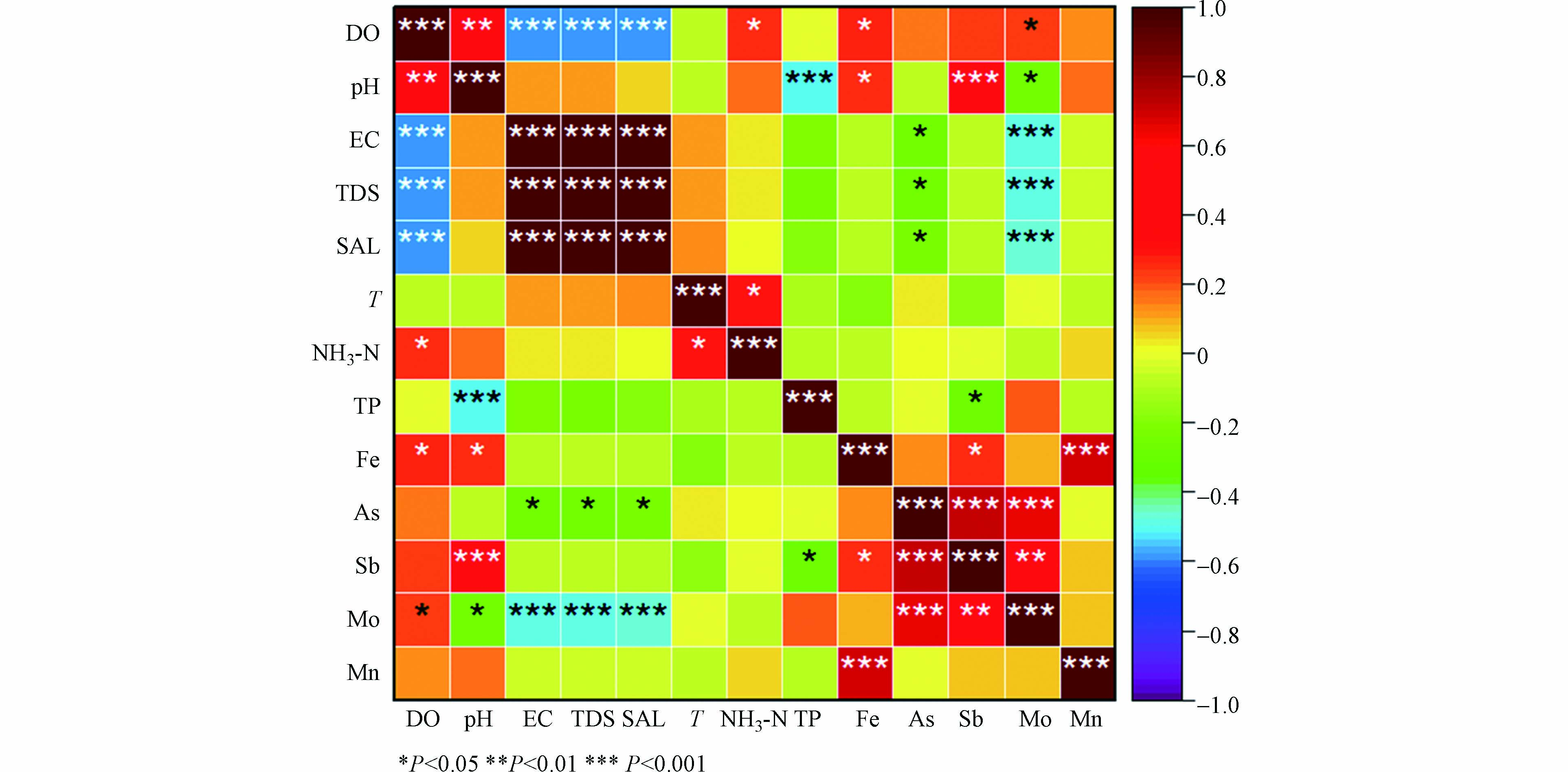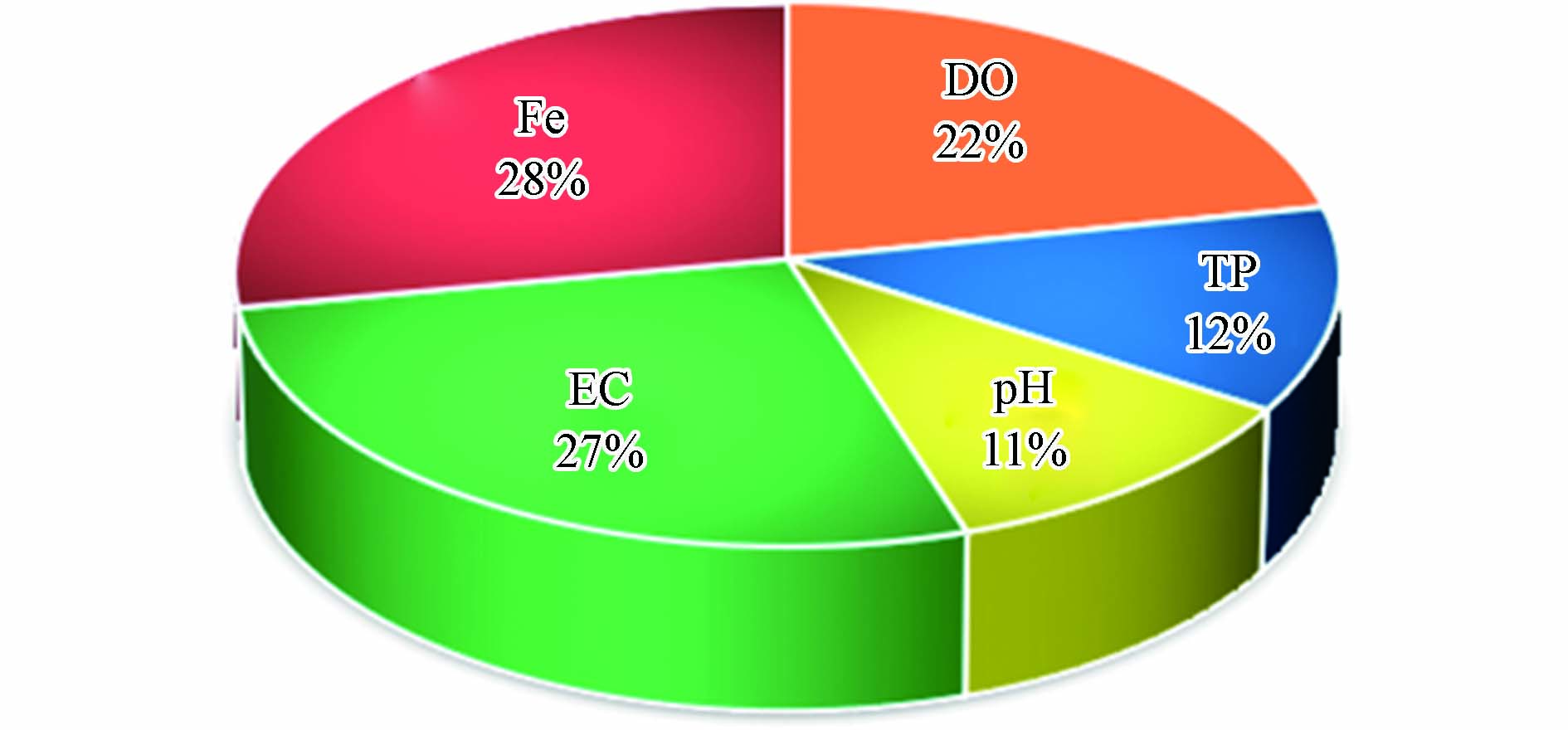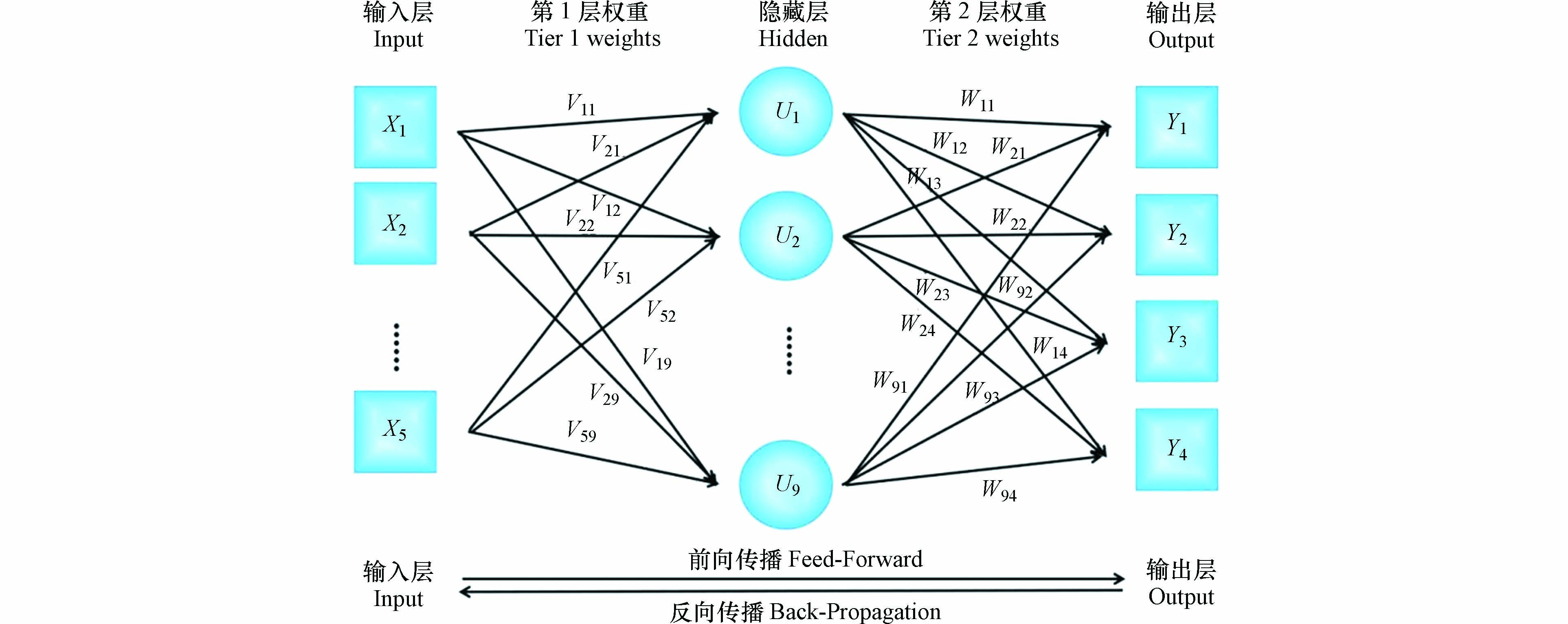-
西藏一江两河(雅鲁藏布江山南段、拉萨河、年楚河)流域地处青藏高原腹地. 该流域面积仅占西藏的5.48%,但人口约占总人口的1/3,经济总量也远超西藏其他区域[1]. 一江两河流域的农业活动和特殊的水文地质,使得水体中重金属含量引起广泛关注. 人工神经网络(ANNs)是以数学模型模拟神经元活动的一种信息处理系统,表现出优于传统模型的特点,是近年来的研究热点[2-3]. 其中,反向传播神经网络(BPNN)是典型的人工神经网络,在水体透明度遥感估算[4]、土壤重金属含量[5]、空气质量指数[6]、降雨量[7]、水中化学需氧量(COD)[8] 和溶解氧 (DO)[9]等预测研究方面具有广泛应用,也可以用于预测水体中重金属浓度.
国外已有较多的研究将BPNN运用到水体重金属预测,Rooki等[10]采用BPNN对酸性矿水中重金属铜(Cu)、铁(Fe)、锰(Mn)、锌(Zn)进行预测,得到预测值与实测值的相关系数R分别为0.92、0.22、0.92和0.92,表明BPNN可以作为一种可行的方法来快速和经济有效地预测酸性矿水中的重金属含量. 国内大多数研究将BPNN运用于水质中其他指标的监测. 符东等[11]为准确掌握沱江水质状况,探明沱江主要污染物,对沱江水质进行了模糊综合评价和BPNN预测. 研究表明,沱江受总氮的污染较为严重,构建沱江的BPNN模型可实现沱江总氮浓度的准确预测. 李峻等[12]以水质因子CODCr为例,构建并训练BPNN预测模型,对青弋江水质进行时空预测,并用实际监测值检验预测精度,结果表明BPNN在青弋江水质的预测方面是一种简单有效的方法. 目前针对青藏高原一江两河流域的研究,很少有直观的针对该流域中水体重金属浓度进行预测,大多数局限于生态风险评价和水质时空特征分析方面. 周晨霓等[13]对西藏拉萨河流域进行水质监测,并利用单污染指数法评价单因子对环境产生的等效影响程度,采用综合指数法评价该流域水质综合质量现状. 李红敬等[14]对雅鲁藏布江的水质研究结果表明,雅鲁藏布江干流中上游江段Cu含量超出渔业水质标准.
青藏高原一江两河流域水环境复杂,地球化学水文地质各因素之间的影响关系不明确,许多仪器和方法在高原上并不适用,传统水质预测方式普遍存在着操作繁琐、预测精度不高等问题,所以亟需寻找一种新的简单可行的途径去预测高原水体中重金属浓度,从而为防治水体重金属污染提供参考依据. BPNN具有强大的非线性映射能力和自动学习、适应能力,在分析处理复杂的水质关系方面,可以提高预测精度,降低预测方式操作难度,得到拟合程度较高的实测值和预测值的曲线. 因此将BPNN用于青藏高原一江两河重金属浓度预测研究是一种新的思路和途径.
年楚河流域农田土壤重金属研究表明砷(As)、Mn在该流域的平均浓度超过其背景值[15]. 西藏中部河流和湖泊表层沉积物重金属研究结果显示锑(Sb)与As显著相关,表明Sb和As来源相似,不仅受到农业活动影响,亦受地热等因素影响[16]. 本文对一江两河流域水体中金属检出水平和Pearson相关性分析,发现钼(Mo)和As、Sb显著相关,表明水体中Mo和As、Sb具有相同来源. 基于以上研究,本文选择以As、Sb、Mn、Mo元素为研究对象,通过建立BPNN模型,预测该流域水环境中4种重金属浓度,旨在了解河流中4种元素的环境行为,进而揭示一江两河流域的水体环境洁净度,为预防青藏高原水环境污染提供数据参考和理论支持.
-
雅鲁藏布江是青藏高原的最长的河流,具有年楚河、拉萨河等主要支流[17]. 研究区域的范围为28°40′44′′N—29°51′38′′N,88°51′50′′E—92°45′34′′E,如图1所示,采样点主要集中在雅鲁藏布江的山南段、年楚河和拉萨河流域,一江两河流域受人类活动影响较大.
水样的采集严格按照《水质采样技术指导》(HJ494-2009). 2021年9—10月,从雅鲁藏布江山南段、拉萨河和年楚河流域采集了75个样品,其中在年楚河流域共41个采样点,编号为N1-41,布设间隔约2.5—10 km;在拉萨河流域共14个采样点,编号为L1-14,布设间隔约5—10 km;在雅鲁藏布江山南段共20个采样点,编号为Y1-20,布设间隔约5—10 km. 采样点平均海拔高度达到3762.68 m,平均大气压约为58.28 kPa.
水质分析检测严格按照《饮用天然矿泉检验方法》(GB 8538-2016)、《生活饮用水标准检验方法》(GB/T 5750-2006)进行. 采用便携式溶氧仪(JPB-607A)和便携式多功能参数测量仪(PCS Testr 35)现场测定:溶解氧(DO)(量程 0.00—20.00 mg·L−1,分辨率 0.01 mg·L−1)、水温(T)(量程 0.0—50.0 ℃,分辨率 0.1 ℃)、电导率(EC)(量程 0.0—199.9 μS·cm−1、200—1999 μS·cm−1、2.00—20.00 mS·cm−1,分辨率 0.1 μS·cm−1、1 μS·cm−1、0.01 mS·cm−1)、pH(量程 0.00—14.00)、总溶解固体(TDS)(量程 0.0—99.9 mg·L−1、100—999 mg·L−1、1.00—10.00 ng·L−1,分辨率0.1 mg·L−1、1 mg·L−1、0.01 ng·L−1)、盐度(SAL)(量程0.0—99.9 mg·L−1、100—999 mg·L−1、1.0—10.00 ng·L−1;分辨率0.1 mg·L−1、1 mg·L−1、0.01 ng·L−1). 通过电感耦合等离子体发射光谱仪(Optima 5300DV)检测Fe(方法检出限MDL:0.0045 mg·L−1)、Sb(MDL:0.000078 mg·L−1)、Mo(MDL:0.00006 mg·L−1)、Mn(MDL:0.00006 mg·L−1);原子荧光光谱仪(AFS-830)检测As(MDL:0.0004 mg·L−1);紫外可见分光光度计(Lamda35)检测氨氮含量(NH3-N)(MDL:0.02 mg·L−1)和总磷(TP)(MDL:0.01 mg·L−1).
-
运用ArcGIS 10.7作研究区域图,通过Origin 2021对输入层变量进行Pearson相关性分析,再用MATLAB R2020b处理水样数据. 本研究将水样的DO、pH、EC、TP和Fe为神经网络的输入层,以As、Sb、Mo、Mn含量作为网络的输出层. 最佳隐藏层的确定是基于MATLAB R2020b神经网络的Levenberg-Marquardt (LM)的算法训练,计算部分分为训练集、验证集和测试集的3组,以数据70%为训练集,验证集和测试集各15%,训练次数1000次,选出最佳的R值和MSE值.
-
由于水体中重金属行为的复杂性,输入数据大小和输入参数多少不能确保测试阶段模型的运行一定不会出现错误[18]. 因此,识别最佳输入组合是模型建立的第一步. Fe在西藏河流含量丰富,而且Fe的产生与其他金属关系密切[19-20]. 因此,为了更好的建模效果,本研究选择Fe为输入参数,此外,DO、pH、EC、TDS、SAL、T、NH3-N、TP的值被认为是输入参数的候选者.
-
BPNN采用三层网络结构,由输入层、隐藏层和输出层组成,通过LM算法训练,如图2所示,LM是一种经典的反向传播算法和启发式算法,依靠数值优化技术来加速计算过程,从而实现更快的训练[21]. BPNN的最佳隐藏神经元数量由试错程序确定.
在前向传播公式中隐藏层神经元
uj 的输出,如公式(1)所示:式中,
vij 为第i个输入变量与第j个隐藏层神经元的权重;buj 为隐藏层u第j个神经元的阀值,或者称为偏置项.在前向传播公式中输出层神经元
yk 的输出,如公式(2)所示:式中, w jk 为第 j 个隐藏层神经元与第 k 个输出层神经元的权重; byk 为输出层 y 第 k 个神经元的阀值,激活函数由MATLAB R2020b中的tansig、logsig和purelin选择.
在反向传播过程中,使用平方误差函数,得到第p个样本的误差
Ep . 目标旨在让真实值与预测值之间的误差尽可能小[22],目标函数(3)设定为:式中,
ˆypk 是神经网络预测的输出值,ypk 是真实的输出值.LM算法类似于牛顿式中Hessian矩阵[22] ,如公式(4):
式中,J是雅可比矩阵,包含权重和偏差的网络误差的一阶导数;E是网络误差的向量;μ是一个标量,其初始值为 0.001;I是单位矩阵;Δw表示当前权重值的调整.
采用的三层网络. 隐藏层中的数量由方程式中给出的经验公式(5)进行估算[23]:
其中,m是隐藏层中的神经元数量;n是输入变量的数量;q是输出变量的数量;a是 0—10之间的常数,通过反复试验确定其最佳值并逐渐改变隐藏层中的节点数来确定隐藏层的最佳神经元数. 由此可得隐藏层神经元m在3—13范围内,选择RMSE相对较小,R相对较大的最佳隐藏层神经元数.
-
通过决定系数R2和均方根误差RMSE的误差来评估模型的性能. R2用于评估模型的预测能力和准确性,如方程式(6)所示[24]:
RMSE是实测值( yj)和预测值(
ˆyj )之间差异的量度,用方程式(7)表示[25]:R2值越高,RMSE值越低,表明适应度越好,实测与预测之间的差异越小. 通常,R2大于0.6且RMSE小于实测值范围的10%被认为是两个系列之间的可接受适应度.
-
(1) 输入选择
已有研究表明,Fe、As、Sb、Mo和Mn的出现通常与工业活动有关[26]. 但是青藏高原受工业污染较轻,因此河流中这些元素主要受到农业活动和高原地质影响[27-32]. pH值会影响水中TP、Fe、Sb和Mo的浓度. 此外,pH值和DO会影响水中Mo、Fe的形态. As和Mo可以传导电流,呈现固有的EC值[33-34]. 考虑到Pearson相关系数的统计分析和显著性分析,选择最优输入变量组合来估计重金属浓度,从图3可以看出,除了T和NH3-N,其他输入变量与预测因子之间的都呈现显著性相关水平(P<0.05),此外,要选择差异大的自变量作为输入变量,由于EC和TDS、SAL具有强相关性,剔除TDS和SAL,因此将DO、pH、EC、TP、Fe作为输入变量.
(2) 输入层贡献值分析
输入层因子DO、pH、EC、TP、Fe单独对As、Sb、Mo、Mn浓度的响应贡献值,如图4所示,DO贡献22%,pH贡献11%,EC贡献27%,TP贡献12%,Fe贡献28%.
运用PMF软件计算出5个输入层因子对单独输出层元素As、Sb、Mo、Mn相对贡献指纹图,如图5所示. (1)如果输出层是As,DO贡献63.5%,pH贡献4.6%,EC贡献0.3%,TP贡献5.9%,Fe贡献25.7%;(2)如果输出层是Sb,DO贡献5.3%,pH贡献78.9%,EC贡献3.6%,TP贡献5.3%,Fe贡献6.9%;(3)如果输出层是Mo,DO贡献6.5%,EC贡献7.1%,TP贡献70.6%,Fe贡献15.8%;(4)如果输出层是Mn,pH贡献5.6%,EC贡献57.2%,Fe贡献37.2%.
(3) 输出选择
BPNN模型构建需要确定输入层数据和输出层数据,输入层数据为不同输入因子的实测值,由Pearson分析确定为DO、pH、EC、TP、Fe,输出层数据为水体中重金属(As、Sb、Mo、Mn)浓度的预测值. 运用Matlab神经网络可以得到4个预测因子 (隐藏层神经元数在m=3—13范围内) 的相关系数 (R) 和均方误差 (MSE) 值. 从表1 重金属浓度预测值和实测值的R和MSE可以看出,无论输出层为单元素(As、Sb、Mo、Mn),还是4个元素共同作为输出层,最佳隐藏层神经元数都为9.
(4) 模型结构
BPNN隐含层神经元的传递函数采用双曲正切S形函数tansig,输出层神经元传递函数采用线性激励函数purelin,训练函数为trainlm,训练算法为LM. 具体的BPNN结构:(1)单元素作为输出层: BPNN结构是5-9-1 ;(2)4个元素共同作为输出层:如图6所示,BPNN结构是5-9-4.
-
根据构建的BPNN预测模型,MATLAB进行编程,利用样本数据进行预测,重金属预测值与实测值的相关系数(R)、决定系数(R2)、均方误差(MSE)、均方根误差(RMSE)如图7 所示. 通过训练集、验证集、测试集曲线拟合得到综合曲线. 综合曲线反应了各元素预测值(P)和实测值(M)的相关性,如As预测值和实测值的关系曲线(图7a):P=0.98×M-3.1×10−5,相关系数R=0.99,决定系数R2=0.98,最优迭代26次时,均方误差MSE=9.4417×10−7,均方根误差RMSE=9.7168×10−4. 同理Sb预测值和实测值的关系曲线(图7b):P=0.96×M+1.4×10−5,相关系数R=0.966,决定系数R2=0.933,最优迭代16次时,均方误差MSE=1.5644×10−8,均方根误差RMSE=1.2508×10−4;Mo的预测值和实测值的关系曲线(图7c):P=0.96×M+8.3×10−5,相关系数R=0.946,决定系数R2=0.894,最优迭代13次时,均方误差MSE=1.0995×10−7,均方根误差RMSE=3.3159×10−4;Mn的预测值和实测值的关系曲线(图7d):P=0.91×M+1.5×10−4,相关系数R=0.963,决定系数R2=0.928,最优迭代10次时,均方误差MSE=3.6817×10−6,均方根误差RMSE=1.9188×10−3;4个元素的预测值和实测值的关系曲线(图7e):P=0.96×M+6×10−5,相关系数R=0.942,决定系数R2=0.888,最优迭代21次时,均方误差MSE=4.7376×10−6,均方根误差RMSE=2.1766×10−3.
R 越接近1,相关性越高,预测值和实测值越接近,表明拟合程度越好,预测精度越高. 从图7 中R值对比看出,(1)BPNN模型对4个元素预测效果排序:As(0.99)
> Sb(0.966)> Mn(0.963)> Mo(0.946);(2) BPNN模型单独对4个元素预测效果比同时对4个元素预测效果好. 该模型预测重金属As、Sb、Mo、Mn浓度拟合直线明显靠近期望值1∶1直线,MSE数值越低,说明预测效果较好,用该预测模型进行河流重金属浓度的预测是可行的.R2值都达到0.6以上,且RMSE值小于实测值范围的10%,说明该预测模型能较好应用于西藏一江两河流域水体中重金属浓度的预测.
-
青藏高原地理位置特殊,水体环境复杂,本研究通过建立BPNN模型对一江两河流域水体中重金属浓度进行预测,提高了预测精度,降低了操作难度,得到的各重金属浓度实测值和预测值的曲线且拟合程度较高,能够较好地监测一江两河流域水体中重金属的浓度,揭示水环境的清洁程度,进而为研究青藏高原其他水体中重金属浓度预测提供参考.
(1) BPNN模型以DO、pH、EC、TP、Fe作为网络的输入层,以As、Sb、Mo、Mn的含量单独或共同作为网络的输出层进行对比分析,使用LM算法进行训练. 研究发现每个元素单独作为输出层时BPNN的拟合效果会比共同作为输出层更好.
(2) BPNN对As、Sb、Mo、Mn预测效果排序:As
> Sb> Mn> Mo,整体来说,模型对As拟合程度最好,预测精度也相对最高.
基于BPNN的一江两河流域水体中重金属浓度预测
Prediction of heavy metal concentration in water of one river and two tributaries based on BPNN
-
摘要: 本文将反向传播神经网络(BPNN)应用于青藏高原一江两河流域(雅鲁藏布江山南段、拉萨河、年楚河)水体中重金属浓度预测,探讨了输入变量、预测因子、隐藏层节点数和模型结构的影响. 模型以溶解氧(DO)、pH、电导率(EC)、总磷(TP)、铁(Fe)作为网络的输入层,重金属砷(As)、锑(Sb)、钼(Mo)、锰(Mn)的含量作为网络的输出层,使用Levenberg-Marquardt (LM)算法进行训练. 其中,BPNN隐藏层的传递函数为tansig,隐藏层节点数为9,输出层的传递函数为purelin,输出层节点数为4. 结果表明:(1)以单个元素作为预测因子时,As、Sb、Mo、Mn预测值和实测值的决定系数(R2)分别为0.98、0.933、0.894、0.928;均方根误差(RMSE)分别为:9.7168×10−4、1.2508×10−4、3.3159×10−4、1.9188×10−3. (2)以4个元素作为预测因子时,预测值和实测值的决定系数(R2)为0.888;均方根误差(RMSE)为2.1766×10−3. R2值越高,RMSE值越低,表明实测值和预测值拟合程度和适应性良好,证明BPNN能较好地应用于青藏高原一江两河流域水体中重金属浓度预测.
-
关键词:
- 反向传播神经网络(BPNN) /
- 一江两河流域 /
- 重金属 /
- 青藏高原
Abstract: In this paper, backpropagation neural network (BPNN) is applied to the prediction of heavy metal concentration in water bodies of one river and two tributaries basins (the Shannan section of Yarlung Tsangpo River, Lhasa River and Nianchu River) of the Qinghai-Tibet Plateau, and the influence of input variables, predictors, number of hidden layer nodes and model structure are discussed. The model uses dissolved oxygen (DO), pH, electrical conductivity (EC), total phosphorus (TP) and iron (Fe) as the input layer of the network, and the content of heavy metals arsenic (As), antimony (Sb), molybdenum (Mo) and manganese (Mn) as the output layer of the network. Levenberg-Marquardt (LM) algorithm is used for training. The transfer function of the BPNN hidden layer is tansig and the number of nodes in the hidden layer is 9, and the transfer function of the output layer is purelin and the number of nodes in the output layer is 4. The results showed that : (1) When a single element was used as a predictor, the determination coefficients (R2) of the predicted and measured values of As, Sb, Mo and Mn were 0.98, 0.933, 0.894 and 0.928, respectively. The root mean square error (RMSE) was 9.7168×10−4, 1.2508×10−4, 3.3159×10−4 and 1.9188×10−3, respectively. (2) When the four elements were used as predictors, the determination coefficients (R2) between the predicted and measured values was 0.888. The root mean square error (RMSE) was 2.1766×10−3. The higher the R2 value, the lower the RMSE value, indicating that the measured and predicted values are well fitted and adaptable, which proves that BPNN can be better applied to the prediction of heavy metal concentrations in water bodies in one river and two tributaries basins on the Qinghai-Tibet Plateau. -
西藏一江两河(雅鲁藏布江山南段、拉萨河、年楚河)流域地处青藏高原腹地. 该流域面积仅占西藏的5.48%,但人口约占总人口的1/3,经济总量也远超西藏其他区域[1]. 一江两河流域的农业活动和特殊的水文地质,使得水体中重金属含量引起广泛关注. 人工神经网络(ANNs)是以数学模型模拟神经元活动的一种信息处理系统,表现出优于传统模型的特点,是近年来的研究热点[2-3]. 其中,反向传播神经网络(BPNN)是典型的人工神经网络,在水体透明度遥感估算[4]、土壤重金属含量[5]、空气质量指数[6]、降雨量[7]、水中化学需氧量(COD)[8] 和溶解氧 (DO)[9]等预测研究方面具有广泛应用,也可以用于预测水体中重金属浓度.
国外已有较多的研究将BPNN运用到水体重金属预测,Rooki等[10]采用BPNN对酸性矿水中重金属铜(Cu)、铁(Fe)、锰(Mn)、锌(Zn)进行预测,得到预测值与实测值的相关系数R分别为0.92、0.22、0.92和0.92,表明BPNN可以作为一种可行的方法来快速和经济有效地预测酸性矿水中的重金属含量. 国内大多数研究将BPNN运用于水质中其他指标的监测. 符东等[11]为准确掌握沱江水质状况,探明沱江主要污染物,对沱江水质进行了模糊综合评价和BPNN预测. 研究表明,沱江受总氮的污染较为严重,构建沱江的BPNN模型可实现沱江总氮浓度的准确预测. 李峻等[12]以水质因子CODCr为例,构建并训练BPNN预测模型,对青弋江水质进行时空预测,并用实际监测值检验预测精度,结果表明BPNN在青弋江水质的预测方面是一种简单有效的方法. 目前针对青藏高原一江两河流域的研究,很少有直观的针对该流域中水体重金属浓度进行预测,大多数局限于生态风险评价和水质时空特征分析方面. 周晨霓等[13]对西藏拉萨河流域进行水质监测,并利用单污染指数法评价单因子对环境产生的等效影响程度,采用综合指数法评价该流域水质综合质量现状. 李红敬等[14]对雅鲁藏布江的水质研究结果表明,雅鲁藏布江干流中上游江段Cu含量超出渔业水质标准.
青藏高原一江两河流域水环境复杂,地球化学水文地质各因素之间的影响关系不明确,许多仪器和方法在高原上并不适用,传统水质预测方式普遍存在着操作繁琐、预测精度不高等问题,所以亟需寻找一种新的简单可行的途径去预测高原水体中重金属浓度,从而为防治水体重金属污染提供参考依据. BPNN具有强大的非线性映射能力和自动学习、适应能力,在分析处理复杂的水质关系方面,可以提高预测精度,降低预测方式操作难度,得到拟合程度较高的实测值和预测值的曲线. 因此将BPNN用于青藏高原一江两河重金属浓度预测研究是一种新的思路和途径.
年楚河流域农田土壤重金属研究表明砷(As)、Mn在该流域的平均浓度超过其背景值[15]. 西藏中部河流和湖泊表层沉积物重金属研究结果显示锑(Sb)与As显著相关,表明Sb和As来源相似,不仅受到农业活动影响,亦受地热等因素影响[16]. 本文对一江两河流域水体中金属检出水平和Pearson相关性分析,发现钼(Mo)和As、Sb显著相关,表明水体中Mo和As、Sb具有相同来源. 基于以上研究,本文选择以As、Sb、Mn、Mo元素为研究对象,通过建立BPNN模型,预测该流域水环境中4种重金属浓度,旨在了解河流中4种元素的环境行为,进而揭示一江两河流域的水体环境洁净度,为预防青藏高原水环境污染提供数据参考和理论支持.
1. 材料和方法(Materials and methods)
1.1 研究区域和样品采集
雅鲁藏布江是青藏高原的最长的河流,具有年楚河、拉萨河等主要支流[17]. 研究区域的范围为28°40′44′′N—29°51′38′′N,88°51′50′′E—92°45′34′′E,如图1所示,采样点主要集中在雅鲁藏布江的山南段、年楚河和拉萨河流域,一江两河流域受人类活动影响较大.
水样的采集严格按照《水质采样技术指导》(HJ494-2009). 2021年9—10月,从雅鲁藏布江山南段、拉萨河和年楚河流域采集了75个样品,其中在年楚河流域共41个采样点,编号为N1-41,布设间隔约2.5—10 km;在拉萨河流域共14个采样点,编号为L1-14,布设间隔约5—10 km;在雅鲁藏布江山南段共20个采样点,编号为Y1-20,布设间隔约5—10 km. 采样点平均海拔高度达到3762.68 m,平均大气压约为58.28 kPa.
水质分析检测严格按照《饮用天然矿泉检验方法》(GB 8538-2016)、《生活饮用水标准检验方法》(GB/T 5750-2006)进行. 采用便携式溶氧仪(JPB-607A)和便携式多功能参数测量仪(PCS Testr 35)现场测定:溶解氧(DO)(量程 0.00—20.00 mg·L−1,分辨率 0.01 mg·L−1)、水温(T)(量程 0.0—50.0 ℃,分辨率 0.1 ℃)、电导率(EC)(量程 0.0—199.9 μS·cm−1、200—1999 μS·cm−1、2.00—20.00 mS·cm−1,分辨率 0.1 μS·cm−1、1 μS·cm−1、0.01 mS·cm−1)、pH(量程 0.00—14.00)、总溶解固体(TDS)(量程 0.0—99.9 mg·L−1、100—999 mg·L−1、1.00—10.00 ng·L−1,分辨率0.1 mg·L−1、1 mg·L−1、0.01 ng·L−1)、盐度(SAL)(量程0.0—99.9 mg·L−1、100—999 mg·L−1、1.0—10.00 ng·L−1;分辨率0.1 mg·L−1、1 mg·L−1、0.01 ng·L−1). 通过电感耦合等离子体发射光谱仪(Optima 5300DV)检测Fe(方法检出限MDL:0.0045 mg·L−1)、Sb(MDL:0.000078 mg·L−1)、Mo(MDL:0.00006 mg·L−1)、Mn(MDL:0.00006 mg·L−1);原子荧光光谱仪(AFS-830)检测As(MDL:0.0004 mg·L−1);紫外可见分光光度计(Lamda35)检测氨氮含量(NH3-N)(MDL:0.02 mg·L−1)和总磷(TP)(MDL:0.01 mg·L−1).
1.2 数据处理
运用ArcGIS 10.7作研究区域图,通过Origin 2021对输入层变量进行Pearson相关性分析,再用MATLAB R2020b处理水样数据. 本研究将水样的DO、pH、EC、TP和Fe为神经网络的输入层,以As、Sb、Mo、Mn含量作为网络的输出层. 最佳隐藏层的确定是基于MATLAB R2020b神经网络的Levenberg-Marquardt (LM)的算法训练,计算部分分为训练集、验证集和测试集的3组,以数据70%为训练集,验证集和测试集各15%,训练次数1000次,选出最佳的R值和MSE值.
1.3 输入识别
由于水体中重金属行为的复杂性,输入数据大小和输入参数多少不能确保测试阶段模型的运行一定不会出现错误[18]. 因此,识别最佳输入组合是模型建立的第一步. Fe在西藏河流含量丰富,而且Fe的产生与其他金属关系密切[19-20]. 因此,为了更好的建模效果,本研究选择Fe为输入参数,此外,DO、pH、EC、TDS、SAL、T、NH3-N、TP的值被认为是输入参数的候选者.
1.4 反向传播神经网络 (BPNN) 模型
BPNN采用三层网络结构,由输入层、隐藏层和输出层组成,通过LM算法训练,如图2所示,LM是一种经典的反向传播算法和启发式算法,依靠数值优化技术来加速计算过程,从而实现更快的训练[21]. BPNN的最佳隐藏神经元数量由试错程序确定.
在前向传播公式中隐藏层神经元
uj uj=f(∑ni=1vijxi+buj)j=1,2,⋯,m (1) 式中,
vij buj 在前向传播公式中输出层神经元
yk yk=f(∑mj=1wjkuj+byk)k=1,2,⋯,q (2) 式中, w jk 为第 j 个隐藏层神经元与第 k 个输出层神经元的权重; byk 为输出层 y 第 k 个神经元的阀值,激活函数由MATLAB R2020b中的tansig、logsig和purelin选择.
在反向传播过程中,使用平方误差函数,得到第p个样本的误差
Ep Ep=12∑qk=1(ˆypk−ypk)2 (3) 式中,
ˆypk ypk LM算法类似于牛顿式中Hessian矩阵[22] ,如公式(4):
Δw=(JTJ+μI)−1JTE (4) 式中,J是雅可比矩阵,包含权重和偏差的网络误差的一阶导数;E是网络误差的向量;μ是一个标量,其初始值为 0.001;I是单位矩阵;Δw表示当前权重值的调整.
采用的三层网络. 隐藏层中的数量由方程式中给出的经验公式(5)进行估算[23]:
m=√n+q+a (5) 其中,m是隐藏层中的神经元数量;n是输入变量的数量;q是输出变量的数量;a是 0—10之间的常数,通过反复试验确定其最佳值并逐渐改变隐藏层中的节点数来确定隐藏层的最佳神经元数. 由此可得隐藏层神经元m在3—13范围内,选择RMSE相对较小,R相对较大的最佳隐藏层神经元数.
1.5 模型性能评估
通过决定系数R2和均方根误差RMSE的误差来评估模型的性能. R2用于评估模型的预测能力和准确性,如方程式(6)所示[24]:
R2=1−∑mj=1(yj−ˆyj)2∑mj=1y2j−∑mj=1ˆy2jm (6) RMSE是实测值( yj)和预测值(
ˆyj RMSE=√∑mj=1(yj−ˆyj)2m (7) R2值越高,RMSE值越低,表明适应度越好,实测与预测之间的差异越小. 通常,R2大于0.6且RMSE小于实测值范围的10%被认为是两个系列之间的可接受适应度.
2. 结果和讨论(Results and discussion)
2.1 模型建立
(1) 输入选择
已有研究表明,Fe、As、Sb、Mo和Mn的出现通常与工业活动有关[26]. 但是青藏高原受工业污染较轻,因此河流中这些元素主要受到农业活动和高原地质影响[27-32]. pH值会影响水中TP、Fe、Sb和Mo的浓度. 此外,pH值和DO会影响水中Mo、Fe的形态. As和Mo可以传导电流,呈现固有的EC值[33-34]. 考虑到Pearson相关系数的统计分析和显著性分析,选择最优输入变量组合来估计重金属浓度,从图3可以看出,除了T和NH3-N,其他输入变量与预测因子之间的都呈现显著性相关水平(P<0.05),此外,要选择差异大的自变量作为输入变量,由于EC和TDS、SAL具有强相关性,剔除TDS和SAL,因此将DO、pH、EC、TP、Fe作为输入变量.
(2) 输入层贡献值分析
输入层因子DO、pH、EC、TP、Fe单独对As、Sb、Mo、Mn浓度的响应贡献值,如图4所示,DO贡献22%,pH贡献11%,EC贡献27%,TP贡献12%,Fe贡献28%.
运用PMF软件计算出5个输入层因子对单独输出层元素As、Sb、Mo、Mn相对贡献指纹图,如图5所示. (1)如果输出层是As,DO贡献63.5%,pH贡献4.6%,EC贡献0.3%,TP贡献5.9%,Fe贡献25.7%;(2)如果输出层是Sb,DO贡献5.3%,pH贡献78.9%,EC贡献3.6%,TP贡献5.3%,Fe贡献6.9%;(3)如果输出层是Mo,DO贡献6.5%,EC贡献7.1%,TP贡献70.6%,Fe贡献15.8%;(4)如果输出层是Mn,pH贡献5.6%,EC贡献57.2%,Fe贡献37.2%.
(3) 输出选择
BPNN模型构建需要确定输入层数据和输出层数据,输入层数据为不同输入因子的实测值,由Pearson分析确定为DO、pH、EC、TP、Fe,输出层数据为水体中重金属(As、Sb、Mo、Mn)浓度的预测值. 运用Matlab神经网络可以得到4个预测因子 (隐藏层神经元数在m=3—13范围内) 的相关系数 (R) 和均方误差 (MSE) 值. 从表1 重金属浓度预测值和实测值的R和MSE可以看出,无论输出层为单元素(As、Sb、Mo、Mn),还是4个元素共同作为输出层,最佳隐藏层神经元数都为9.
表 1 重金属浓度预测值和实测值的R和MSE值Table 1. The R and MSE values with predicted and measured heavy metal concentrationsm 砷 As 锑 Sb 钼 Mo 锰 Mn 砷、锑、钼、锰共同输出Common output R MSE R MSE R MSE R MSE R MSE 3 0.93123 1.4421×10−6 0.94879 4.1252×10−8 0.89247 4.982×10−7 0.90532 6.1007×10−6 0.90946 3.553×10−6 4 0.96537 2.3252×10−6 0.93571 4.7251×10−8 0.89988 4.2321×10−7 0.92603 1.9196×10−6 0.91861 1.7203×10−6 5 0.96925 7.5378×10−6 0.9193 2.6065×10−8 0.89576 2.1519×10−7 0.94441 2.3075×10−6 0.91739 1.567×10−6 6 0.96464 8.0868×10−7 0.94248 2.809×10−8 0.91896 1.3364×10−7 0.93395 2.7313×10−6 0.91548 3.9952×10−6 7 0.97951 1.8694×10−6 0.95308 6.7504×10−8 0.92315 3.1197×10−7 0.95523 4.1893×10−6 0.91648 5.2032×10−6 8 0.97774 2.8463×10−6 0.94575 4.5302×10−8 0.92513 2.7051×10−7 0.95293 5.9712×10−6 0.93654 4.5672×10−6 9 0.98978 9.4417×10−7 0.96594 1.5644×10−8 0.94555 1.0995×10−7 0.96337 3.6817×10−6 0.94235 4.7376×10−6 10 0.94838 1.7545×10−6 0.93021 3.8875×10−8 0.90364 1.2402×10−7 0.9602 3.5023×10−6 0.91799 5.3717×10−6 11 0.95096 8.1691×10−6 0.95992 3.0469×10−8 0.92018 1.7863×10−7 0.925 1.9336×10−6 0.91465 3.115×10−6 12 0.96107 5.8699×10−6 0.92848 2.0744×10−7 0.93814 4.9283×10−8 0.95628 5.6111×10−6 0.92473 2.1818×10−6 13 0.94508 6.7089×10−6 0.92151 1.1668×10−7 0.92059 3.4499×10−7 0.94545 1.9454×10−6 0.92939 1.3172×10−6 注:m:隐藏层数;R:相关系数;MSE:均方误差. (4) 模型结构
BPNN隐含层神经元的传递函数采用双曲正切S形函数tansig,输出层神经元传递函数采用线性激励函数purelin,训练函数为trainlm,训练算法为LM. 具体的BPNN结构:(1)单元素作为输出层: BPNN结构是5-9-1 ;(2)4个元素共同作为输出层:如图6所示,BPNN结构是5-9-4.
2.2 预测结果及分析
根据构建的BPNN预测模型,MATLAB进行编程,利用样本数据进行预测,重金属预测值与实测值的相关系数(R)、决定系数(R2)、均方误差(MSE)、均方根误差(RMSE)如图7 所示. 通过训练集、验证集、测试集曲线拟合得到综合曲线. 综合曲线反应了各元素预测值(P)和实测值(M)的相关性,如As预测值和实测值的关系曲线(图7a):P=0.98×M-3.1×10−5,相关系数R=0.99,决定系数R2=0.98,最优迭代26次时,均方误差MSE=9.4417×10−7,均方根误差RMSE=9.7168×10−4. 同理Sb预测值和实测值的关系曲线(图7b):P=0.96×M+1.4×10−5,相关系数R=0.966,决定系数R2=0.933,最优迭代16次时,均方误差MSE=1.5644×10−8,均方根误差RMSE=1.2508×10−4;Mo的预测值和实测值的关系曲线(图7c):P=0.96×M+8.3×10−5,相关系数R=0.946,决定系数R2=0.894,最优迭代13次时,均方误差MSE=1.0995×10−7,均方根误差RMSE=3.3159×10−4;Mn的预测值和实测值的关系曲线(图7d):P=0.91×M+1.5×10−4,相关系数R=0.963,决定系数R2=0.928,最优迭代10次时,均方误差MSE=3.6817×10−6,均方根误差RMSE=1.9188×10−3;4个元素的预测值和实测值的关系曲线(图7e):P=0.96×M+6×10−5,相关系数R=0.942,决定系数R2=0.888,最优迭代21次时,均方误差MSE=4.7376×10−6,均方根误差RMSE=2.1766×10−3.
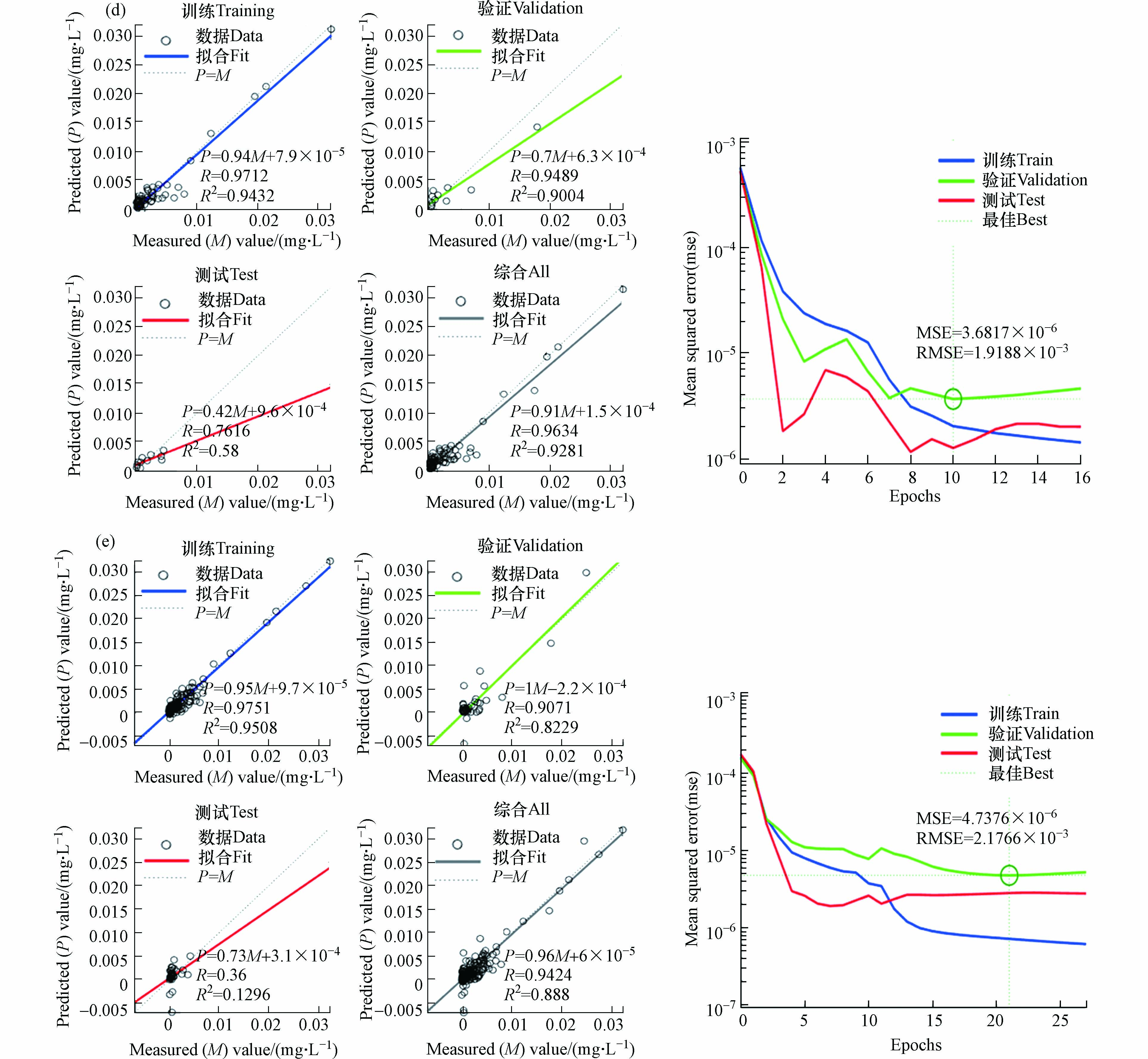 图 7 重金属预测值与实测值的相关系数(R)、决定系数(R2)、均方误差(MSE)、均方根误差(RMSE)Figure 7. Correlation coefficient (R), coefficient of determination (R2), mean square error (MSE), root mean square error (RMSE) of predicted and measured heavy metal values(输入变量As:(a), Sb:(b), Mo:(c), Mn:(d), As、Sb、Mo、Mn:(e))(input variables As: (a), Sb (b), Mo (c), Mn (d), As, Sb, Mo, Mn: (e))
图 7 重金属预测值与实测值的相关系数(R)、决定系数(R2)、均方误差(MSE)、均方根误差(RMSE)Figure 7. Correlation coefficient (R), coefficient of determination (R2), mean square error (MSE), root mean square error (RMSE) of predicted and measured heavy metal values(输入变量As:(a), Sb:(b), Mo:(c), Mn:(d), As、Sb、Mo、Mn:(e))(input variables As: (a), Sb (b), Mo (c), Mn (d), As, Sb, Mo, Mn: (e))R 越接近1,相关性越高,预测值和实测值越接近,表明拟合程度越好,预测精度越高. 从图7 中R值对比看出,(1)BPNN模型对4个元素预测效果排序:As(0.99)
> > > R2值都达到0.6以上,且RMSE值小于实测值范围的10%,说明该预测模型能较好应用于西藏一江两河流域水体中重金属浓度的预测.
3. 结论(Conclusion)
青藏高原地理位置特殊,水体环境复杂,本研究通过建立BPNN模型对一江两河流域水体中重金属浓度进行预测,提高了预测精度,降低了操作难度,得到的各重金属浓度实测值和预测值的曲线且拟合程度较高,能够较好地监测一江两河流域水体中重金属的浓度,揭示水环境的清洁程度,进而为研究青藏高原其他水体中重金属浓度预测提供参考.
(1) BPNN模型以DO、pH、EC、TP、Fe作为网络的输入层,以As、Sb、Mo、Mn的含量单独或共同作为网络的输出层进行对比分析,使用LM算法进行训练. 研究发现每个元素单独作为输出层时BPNN的拟合效果会比共同作为输出层更好.
(2) BPNN对As、Sb、Mo、Mn预测效果排序:As
> > > -
表 1 重金属浓度预测值和实测值的R和MSE值
Table 1. The R and MSE values with predicted and measured heavy metal concentrations
m 砷 As 锑 Sb 钼 Mo 锰 Mn 砷、锑、钼、锰共同输出Common output R MSE R MSE R MSE R MSE R MSE 3 0.93123 1.4421×10−6 0.94879 4.1252×10−8 0.89247 4.982×10−7 0.90532 6.1007×10−6 0.90946 3.553×10−6 4 0.96537 2.3252×10−6 0.93571 4.7251×10−8 0.89988 4.2321×10−7 0.92603 1.9196×10−6 0.91861 1.7203×10−6 5 0.96925 7.5378×10−6 0.9193 2.6065×10−8 0.89576 2.1519×10−7 0.94441 2.3075×10−6 0.91739 1.567×10−6 6 0.96464 8.0868×10−7 0.94248 2.809×10−8 0.91896 1.3364×10−7 0.93395 2.7313×10−6 0.91548 3.9952×10−6 7 0.97951 1.8694×10−6 0.95308 6.7504×10−8 0.92315 3.1197×10−7 0.95523 4.1893×10−6 0.91648 5.2032×10−6 8 0.97774 2.8463×10−6 0.94575 4.5302×10−8 0.92513 2.7051×10−7 0.95293 5.9712×10−6 0.93654 4.5672×10−6 9 0.98978 9.4417×10−7 0.96594 1.5644×10−8 0.94555 1.0995×10−7 0.96337 3.6817×10−6 0.94235 4.7376×10−6 10 0.94838 1.7545×10−6 0.93021 3.8875×10−8 0.90364 1.2402×10−7 0.9602 3.5023×10−6 0.91799 5.3717×10−6 11 0.95096 8.1691×10−6 0.95992 3.0469×10−8 0.92018 1.7863×10−7 0.925 1.9336×10−6 0.91465 3.115×10−6 12 0.96107 5.8699×10−6 0.92848 2.0744×10−7 0.93814 4.9283×10−8 0.95628 5.6111×10−6 0.92473 2.1818×10−6 13 0.94508 6.7089×10−6 0.92151 1.1668×10−7 0.92059 3.4499×10−7 0.94545 1.9454×10−6 0.92939 1.3172×10−6 注:m:隐藏层数;R:相关系数;MSE:均方误差. -
[1] 陈安, 李景吉, 王茂生, 等. 西藏“一江两河”流域生态系统服务变化及权衡与协同关系研究 [J]. 水土保持研究, 2022, 29(2): 313-319. CHEN A, LI J J, WANG M S, et al. Research for change of ecosystem service and the tradeoff-synergy relation of the YLN Basin in the Tibet Autonomous Region [J]. Research of Soil and Water Conservation, 2022, 29(2): 313-319(in Chinese).
[2] ARDABILI S, MOSAVI A, DEHGHANI M, et al. Deep learning and machine learning in hydrological processes climate change and earth systems a systematic review[C]//Várkonyi-Kóczy A. International Conference on Global Research and Education. Cham: Springer, 2020: 52-62. [3] BEJOU D, WRAY B, INGRAM T N. Determinants of relationship quality: An artificial neural network analysis [J]. Journal of Business Research, 1996, 36(2): 137-143. doi: 10.1016/0148-2963(95)00100-X [4] 刁瑞翔, 青松, 越亚嫘, 等. 基于BP神经网络算法的内蒙古岱海水体透明度遥感估算 [J]. 灌溉排水学报, 2022, 41(8): 114-121. DIAO R X, QING S, YUE Y L, et al. Using back propagation neural network algorithm and remote sensing to estimate lake water transparency [J]. Journal of Irrigation and Drainage, 2022, 41(8): 114-121(in Chinese).
[5] 黄煜韬, 施维林, 纪娟, 等. 基于BP神经网络对某电镀厂土壤重金属预测及人体健康风险评价 [J]. 生态毒理学报, 2022, 17(2): 278-289. HUANG Y T, SHI W L, JI J, et al. Prediction of soil heavy metals based on BP neural network and assessment of human health risk of an electroplating plant [J]. Asian Journal of Ecotoxicology, 2022, 17(2): 278-289(in Chinese).
[6] 尤游, 张林静. 贝叶斯正则化BP神经网络在空气质量指数预测中的应用 [J]. 重庆科技学院学报(自然科学版), 2022, 24(1): 78-82. YOU Y, ZHANG L J. Application of Bayesian regularized BP neural network in air quality index prediction [J]. Journal of Chongqing University of Science and Technology (Natural Sciences Edition), 2022, 24(1): 78-82(in Chinese).
[7] 朱琳, 李明河, 陈园. 基于EHO优化的BP神经网络污水处理出水COD预测模型 [J]. 重庆工商大学学报(自然科学版), 2022, 39(3): 26-32. ZHU L, LI M H, CHEN Y. Prediction model for effluent COD in sewage treatment based on BP neural network optimized by EHO [J]. Journal of Chongqing Technology and Business University (Natural Science Edition), 2022, 39(3): 26-32(in Chinese).
[8] ANOCHI J A, de CAMPOS VELHO H F. Climate precipitation prediction by neural network [J]. Journal of Mathematics and System Science, 2015, 5(5): 207-213. [9] MOGHADAM S V, SHARAFATI A, FEIZI H, et al. An efficient strategy for predicting river dissolved oxygen concentration: Application of deep recurrent neural network model [J]. Environmental Monitoring and Assessment, 2021, 193(12): 798. doi: 10.1007/s10661-021-09586-x [10] ROOKI R, ARDEJANI F D, ARYAFAR A, et al. Prediction of heavy metals in acid mine drainage using artificial neural network from the Shur River of the Sarcheshmeh porphyry copper mine, Southeast Iran [J]. Environmental Earth Sciences, 2011, 64(5): 1303-1316. doi: 10.1007/s12665-011-0948-5 [11] 符东, 吴雪菲, 易珍言, 等. 沱江水质模糊综合评价及主要污染物的预测研究 [J]. 农业环境科学学报, 2020, 39(12): 2844-2852. FU D, WU X F, YI Z Y, et al. Fuzzy comprehensive assessment of water quality and prediction of main pollutants in the Tuo River [J]. Journal of Agro-Environment Science, 2020, 39(12): 2844-2852(in Chinese).
[12] 李峻, 孙世群. 基于BP网络模型的青弋江水质预测研究 [J]. 安徽工程科技学院学报(自然科学版), 2008, 23(2): 23-26. LI J, SUN S Q. Water quality prediction in qinyijiang River Wuhu area based on BP artificial neural network [J]. Journal of Anhui University of Technology and Science (Natural Science), 2008, 23(2): 23-26(in Chinese).
[13] 周晨霓, 潘刚. 西藏拉萨河流域湿地水质分析与评价 [J]. 贵州农业科学, 2014, 42(9): 249-252. ZHOU C N, PAN G. Analysis and evaluation of water quality of plateau wetlands in Lhasa River basin [J]. Guizhou Agricultural Sciences, 2014, 42(9): 249-252(in Chinese).
[14] 李红敬, 张娜, 林小涛. 西藏雅鲁藏布江水质时空特征分析 [J]. 河南师范大学学报(自然科学版), 2010, 38(2): 126-130. LI H J, ZHANG N, LIN X T. Spatio-temporal characteristics of Yarlung Zangbo River in Tibet [J]. Journal of Henan Normal University (Natural Science), 2010, 38(2): 126-130(in Chinese).
[15] 杜梅, 张强英, 任培, 等. 西藏年楚河流域农用地土壤重金属分布与生态风险评价 [J]. 环境工程技术学报, 2022, 12(5): 1618-1625. DU M, ZHANG Q Y, REN P, et al. Distribution of soil heavy metals and ecological risk assessment of agricultural land in Nianchu River basin, Tibet [J]. Journal of Environmental Engineering Technology, 2022, 12(5): 1618-1625(in Chinese).
[16] 杨安, 邢文聪, 王小霞, 等. 西藏中部河流、湖泊表层沉积物及其周边土壤重金属来源解析及风险评价 [J]. 中国环境科学, 2020, 40(10): 4557-4567. YANG A, XING W C, WANG X X, et al. Source and risk assessment of heavy metals in surface sediments of rivers, lakes and their surrounding soils in central Tibet [J]. China Environmental Science, 2020, 40(10): 4557-4567(in Chinese).
[17] 马腾霄, 杨文光, 朱利东, 等. 雅鲁藏布江中游地貌参数特征及其构造地貌意义 [J]. 成都理工大学学报(自然科学版), 2022, 49(4): 502-512. MA T X, YANG W G, ZHU L D, et al. Geomorphic parameters and their tectonic geomorphic significance in the middle reaches of Yarlung Zangbo River, China [J]. Journal of Chengdu University of Technology (Science & Technology Edition), 2022, 49(4): 502-512(in Chinese).
[18] BRAY M, HAN D W. Identification of support vector machines for runoff modelling [J]. Journal of Hydroinformatics, 2004, 6(4): 265-280. doi: 10.2166/hydro.2004.0020 [19] HONG N, GUAN Y J, YANG B, et al. Quantitative source tracking of heavy metals contained in urban road deposited sediments [J]. Journal of Hazardous Materials, 2020, 393: 122362. doi: 10.1016/j.jhazmat.2020.122362 [20] 万子益. 西藏主要铁矿类型地质特征简介 [J]. 矿床地质, 1986, 5(4): 24-33. WAN Z Y. A brief introduction to the major types of iron deposits in Tibet and their geological setting [J]. Mineral Deposits, 1986, 5(4): 24-33(in Chinese).
[21] 徐宗宝. 基于混合优化BP神经网络的水质预测系统的研究与实现[D]. 北京: 北京工业大学, 2020. XU Z B. Research and realization of water quality prediction system based on hybrid optimized BP neural network[D]. Beijing: Beijing University of Technology, 2020 (in Chinese).
[22] LI P F, HUA P, GUI D W, et al. A comparative analysis of artificial neural networks and wavelet hybrid approaches to long-term toxic heavy metal prediction [J]. Scientific Reports, 2020, 10(1): 1-15. doi: 10.1038/s41598-019-56847-4 [23] 范佳妮, 王振雷, 钱锋. BP人工神经网络隐层结构设计的研究进展[J]. 控制工程, 2005, 12(增刊1): 109-113. FAN J N, WANG Z L, QIAN F. Research progress structural design of hidden layer in BP artificial neural networks[J]. Control Engineering of China, 2005, 12(Sup 1): 109-113. (in Chinese)
[24] 段宁, 杨思言, 魏婉婷. 基于BP神经网络的铅酸蓄电池厂地下水重金属浓度预测 [J]. 环境科学与技术, 2016, 39(1): 194-198. DUAN N, YANG S Y, WEI W T. Prediction of heavy metal concentrations of the groundwater from a lead-acid battery factory based on BP neural network [J]. Environmental Science & Technology, 2016, 39(1): 194-198(in Chinese).
[25] ALEXANDER D L J, TROPSHA A, WINKLER D A. Beware of R2: Simple, unambiguous assessment of the prediction accuracy of QSAR and QSPR models [J]. Journal of Chemical Information and Modeling, 2015, 55(7): 1316-1322. doi: 10.1021/acs.jcim.5b00206 [26] ABDULLAHI N, IGWE E C, DANDAGO M A. Heavy metals contamination sources in Kano, Nigeria and their concentrations along Jakara River and its agricultural produce: A review[J]. Moroccan Journal of Agricultural Sciences 2021, 2(2): 106-113. [27] 胡志华, 高洪雷, 万汉平, 等. 西藏羊八井地热田水热蚀变的时空演化特征 [J]. 地质论评, 2022, 68(1): 359-374. HU Z H, GAO H L, WAN H P, et al. Temporal and spatial evolution of hydrothermal alteration in the Yangbajing Geothermal Field, Xizang(Tibet) [J]. Geological Review, 2022, 68(1): 359-374(in Chinese).
[28] LIU R, XU Y, ZHANG J, et al. A comparative study of the content of heavy metals in typical metallic mine rivers of the Tibetan Plateau [J]. Geological Bulletin of China, 2018, 37(12): 2154-2168. [29] HUANG X, SILLANPÄÄ M, DUO B, et al. Water quality in the Tibetan Plateau: Metal contents of four selected rivers [J]. Environmental Pollution, 2008, 156(2): 270-277. doi: 10.1016/j.envpol.2008.02.014 [30] HUANG X, SILLANPÄÄ M, GJESSING E T, et al. Water quality in the Tibetan Plateau: Major ions and trace elements in the headwaters of four major Asian rivers [J]. Science of the Total Environment, 2009, 407(24): 6242-6254. doi: 10.1016/j.scitotenv.2009.09.001 [31] ZHANG Y L, SILLANPÄÄ M, LI C L, et al. River water quality across the Himalayan regions: Elemental concentrations in headwaters of Yarlung Tsangbo, Indus and Ganges River [J]. Environmental Earth Sciences, 2015, 73(8): 4151-4163. doi: 10.1007/s12665-014-3702-y [32] LIU C W. Reactive transport of arsenic-enriched geothermal spring water into a sedimentary aquifer [J]. Environmental Geochemistry and Health, 2019, 41(2): 633-648. doi: 10.1007/s10653-018-0156-2 [33] H V P T, BONNET T, GARAMBOIS S, et al. Arsenic in shallow aquifers linked to the electrical ground conductivity: The Mekong delta source example [J]. Geosciences Research, 2017, 2(3): 180-195. [34] SHARMA S, KHANDELWAL A, AMALADASS E P, et al. Studies on DC transport and terahertz conductivity of granular molybdenum thin films for microwave radiation detector applications [J]. Journal of Applied Physics, 2020, 128(18): 183901. doi: 10.1063/5.0013939 -




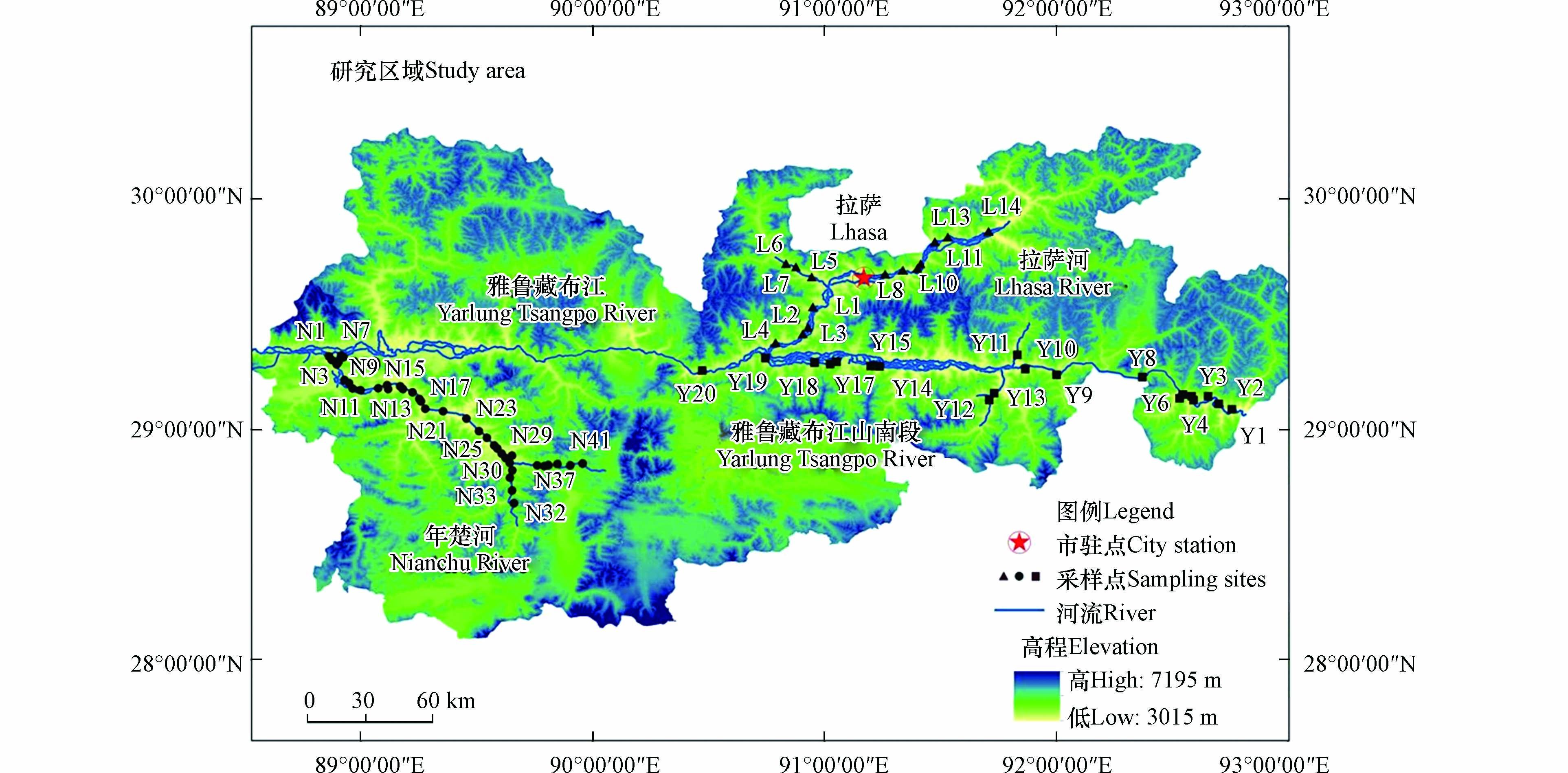
 下载:
下载:
